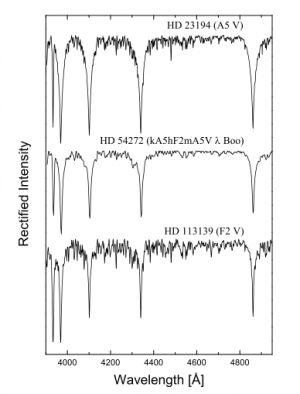Another remarkable star, formerly misclassified as a lambda Bootis and RR Lyrae star, featured in a pre-print on arXiv
 We detect the second known lambda Bootis star (HD 54272) which exhibits gamma Doradus-type pulsations. The star was formerly misidentified as a RR Lyrae variable. The lambda Bootis stars are a small group (only 2 per cent) of late B to early F-type, Population I stars which show moderate to extreme (up to a factor 100) surface underabundances of most Fe-peak elements and solar abundances of lighter elements (C, N, O, and S). The photometric data from the Wide Angle Search for Planets (WASP) and All Sky Automated Survey (ASAS) projects were analysed. They have an overlapping time base of 1566 d and 2545 d, respectively. Six statistically significant peaks were identified (f1 = 1.410 116 c/d, f2 = 1.283 986 c/d, f3 = 1.293 210 c/d, f4 = 1.536 662 c/d, f5 = 1.157 22 c/d and f6 = 0.226 57 c/d). The spacing between f1 and f2, f1 and f4, f5 and f2 is almost identical. Since the daily aliasing is very strong, the interpretation of frequency spectra is somewhat ambiguous. From spectroscopic data, we deduce a high rotational velocity (250+-25 km/s) and a metal deficiency of about -0.8 to -1.1 dex compared to the Sun. A comparison with the similar star, HR 8799, results in analogous pulsational characteristics but widely different astrophysical parameters. Since both are lambda Bootis-type stars, the main mechanism of this phenomenon, selective accretion, may severely influence gamma Doradus-type pulsations.
We detect the second known lambda Bootis star (HD 54272) which exhibits gamma Doradus-type pulsations. The star was formerly misidentified as a RR Lyrae variable. The lambda Bootis stars are a small group (only 2 per cent) of late B to early F-type, Population I stars which show moderate to extreme (up to a factor 100) surface underabundances of most Fe-peak elements and solar abundances of lighter elements (C, N, O, and S). The photometric data from the Wide Angle Search for Planets (WASP) and All Sky Automated Survey (ASAS) projects were analysed. They have an overlapping time base of 1566 d and 2545 d, respectively. Six statistically significant peaks were identified (f1 = 1.410 116 c/d, f2 = 1.283 986 c/d, f3 = 1.293 210 c/d, f4 = 1.536 662 c/d, f5 = 1.157 22 c/d and f6 = 0.226 57 c/d). The spacing between f1 and f2, f1 and f4, f5 and f2 is almost identical. Since the daily aliasing is very strong, the interpretation of frequency spectra is somewhat ambiguous. From spectroscopic data, we deduce a high rotational velocity (250+-25 km/s) and a metal deficiency of about -0.8 to -1.1 dex compared to the Sun. A comparison with the similar star, HR 8799, results in analogous pulsational characteristics but widely different astrophysical parameters. Since both are lambda Bootis-type stars, the main mechanism of this phenomenon, selective accretion, may severely influence gamma Doradus-type pulsations.
Authors: E. Paunzen, M. Skarka, D.L. Holdsworth, B. Smalley, R. G. West

